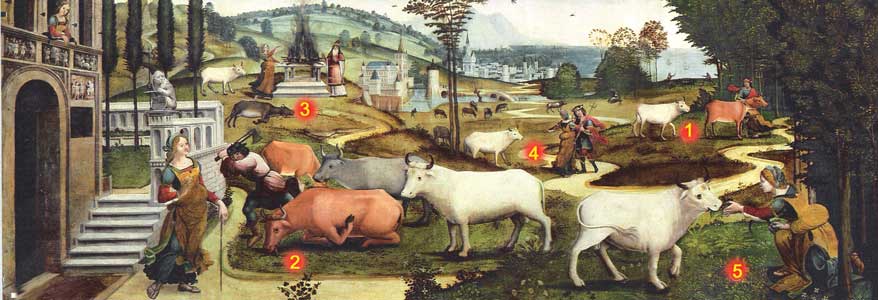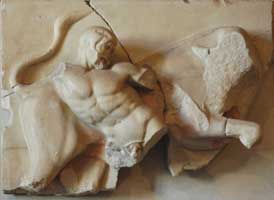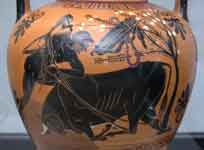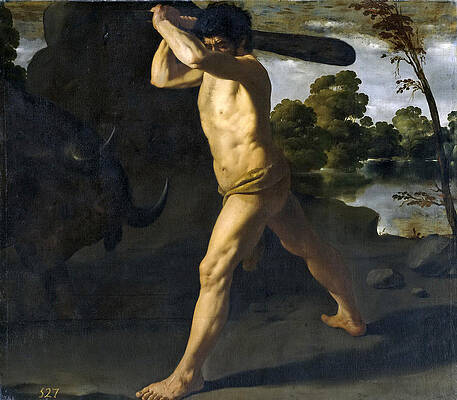.

The Cretan Bull and the History of the Minotaur from Cassone Paintings,16th century.
In Greek mythology, the Cretan Bull was either the bull that carried away Europa or the bull Pasiphae fell in love with.
Capture by Heracles
Heracles was compelled to capture the bull as his seventh task. He sailed to Crete, whereupon the King of Crete, Minos, gave Heracles permission to take the bull away, as it had been wreaking havoc on Crete. Heracles used a lasso and rode it back to his cousin, Eurystheus. Eurystheus wanted to sacrifice the bull to Hera, who hated Heracles. She refused the sacrifice because it reflected glory on Heracles, and the bull was released to be captured by Theseus later.
Origin
When the sun has reached the constellation of Taurus, it has passed over an area that the ancients referred to as the sea - the region from Capricorn to the region containing Aries. It was referred to as the sea due to the high concentration of constellations identified as sea creatures within it, Aries being identified as a flying ram who flew over the sea. Crete is in a direct line from the natural harbour of Argo, a direction which the shape of Argo's harbour, and surrounding coastline, requires all ships initially take.
Apart from being a bull, Taurus contains a very bright and red star, meaning that many took it to be evil. Some forms of Greek mythology associated the constellation with the tame white bull, in some versions Zeus in disguise, that seduced Europa and took her to Crete (Minos), whereas others associate it with the white bull that fathered the Minotaur. The cretan bull which fathered the Minotaur was originally calm and sent from Poseidon, but the king (Minos) whom it was sent to fell out of favour with Poseidon, and so in some versions of the story, Poseidon made the bull angry.
The myth of Poseidon sending the bull (which seduced Minos' wife) may simply be an earlier version of the myth of Zeus seducing Europa, as in earlier Mycenean times, Poseidon had significantly more importance than Zeus. The change of gods was due to the replacement of the Mycenean culture and religion, with a later one favouring Zeus. Poseidon and Zeus, which have the same etymological origin (Poseidon deriving from Posei-Deion which means Lord God, and Zeus deriving from Deus which also means God), may be the result of the parallel evolution of the same original God in separate cultures, one (Poseidon - who is also associated with horses) becoming associated more with the sea (due to change in the main source of trade), and thus eventually becoming noticeably different.
Capture by Theseus
The bull was released and wandered to Marathon, becoming known as the Marathonian Bull, which Theseus was sent to try to catch. On the way to Marathon to capture the Bull, Theseus sought shelter from a storm in the shack owned by an ancient lady named Hecale. She swore to make a sacrifice to Zeus if Theseus was successful in capturing the bull. Theseus did capture the bull but when he returned to Hecale's hut, she was dead. Theseus built a deme in her honor.
Pausanias:
Another deed of Theseus they have represented in an offering, and the story about it is as follows: -- The land of the Cretans and especially that by the river Tethris was ravaged by a bull. It would seem that in the days of old the beasts were much more formidable to men, for example the Nemean lion, the lion of Parnassus, the serpents in many parts of Greece, and the boars of Calydon, Eryrmanthus and Crommyon in the land of Corinth, so that it was said that some were sent up by the earth, that others were sacred to the gods, while others had been let loose to punish mankind. And so the Cretans say that this bull was sent by Poseidon to their land because, although Minos was lord of the Greek Sea, he did not worship Poseidon more than any other god.
They say that this bull crossed from Crete to the Peloponnesus, and came to be one of what are called the Twelve Labours of Heracles. When he was let loose on the Argive plain he fled through the isthmus of Corinth, into the land of Attica as far as the Attic parish of Marathon, killing all he met, including Androgeos, son of Minos. Minos sailed against Athens with a fleet, not believing that the Athenians were innocent of the death of Androgeos, and sorely harassed them until it was agreed that he should take seven maidens and seven boys for the Minotaur that was said to dwell in the Labyrinth at Cnossus. But the bull at Marathon Theseus is said to have driven afterwards to the Acropolis and to have sacrificed to the goddess; the offering commemorating this deed was dedicated by the parish of Marathon.
See also
See also : Greek Mythology. Paintings, Drawings
| Ancient Greece
Science, Technology , Medicine , Warfare, , Biographies , Life , Cities/Places/Maps , Arts , Literature , Philosophy ,Olympics, Mythology , History , Images Medieval Greece / Byzantine Empire Science, Technology, Arts, , Warfare , Literature, Biographies, Icons, History Modern Greece Cities, Islands, Regions, Fauna/Flora ,Biographies , History , Warfare, Science/Technology, Literature, Music , Arts , Film/Actors , Sport , Fashion --- |
Retrieved from "http://en.wikipedia.org"
All text is available under the terms of the GNU Free Documentation License





